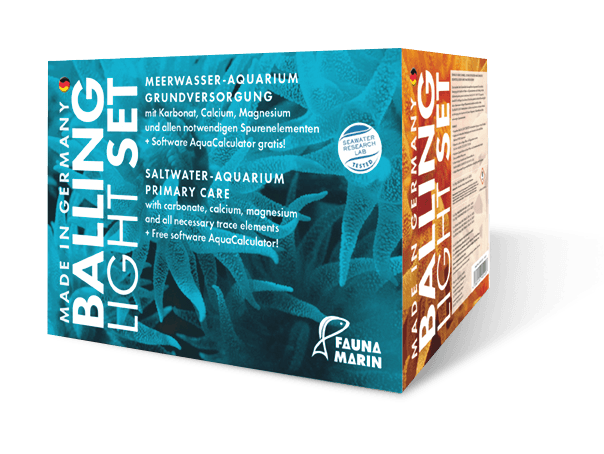Manganese
In natural seawater, manganese is limited and hardly detectable with only a few nanograms. The source for corals is therefore bacteria and algae plankton as well as the food they take up.
The element has a high biological importance as a component of various enzymes. It acts at a central point in the photosynthesis cycle, where a manganese-calcium cluster is responsible for the oxidation of water to oxygen.
What’s this:
Manganese is virtually non-existent in seawater because it precipitates rapidly. This element can only be be detected with the ICP analysis if the concentration is far higher than required. Manganese is an essential element for corals. Like iron, it is a nutrient that is important for the growth. Manganese also has an effect on the red coloration of many corals.
Problems:
A lack of manganese is visible in blunt tissue, reduced or lacking growth, colourless growth tips and retracted polyps in Goniopora and Alveopora corals as well as partial light sensitivity in LPS corals.
Measures:
Regular control of the manganese value and adjustment of the dosage, reduction by partial water change, filtration via zeolite and strong skimming.
Indicator species:
Goniopora green, blue and red, Alveopora species in different colours. In case of slight deficiency, especially the strong red colouring of Goniopora and Montipora species is reduced.
Value too high:
Control of the sea salt (component of the anti-caking aid), reduction of the addition dosage, partial water change, avoid values above 5 µg/l (0,26 US.liq.gal.). Filtering via Zeolight or Phos. Manganese precipitates extremely fast in sea water.
Value too low:
Dose Elementals Trace MN, Organic, Trace 2, Balling-Light-System.
| Variety | heavy metal, nutrient element |
|---|---|
| Benefit | 0,1–0,2 µg/l (0,26 US.liq.gal.) |
| Skill Level | Red, only for experienced aquarists |
| Source | salt, supply systems, trace element mixtures, feed, Artemia |
| Available | Elementals Trace Mn, Color Elements Green Balling-Light-System, Trace 3, feed |
| Importance 1–6 | 5 |
| Detection quality | safe |

Balling Light:
In the Balling-Light system, the manganese is dosed via the Trace-2 and Trace-3 solution. Values between 0.1–0.2 µg/l (0,26 US.liq.gal.) are sufficiently high. In aquaria with regular partial water changes, ICP analyses tend to show higher Mn values, as the anti-caking agents used in the salt are also indicated. However, the manganese is quickly filtered out again. Manganese is added to the basic supply in the subsequent systems via Color Elements Green, Trace 2 and the product Organic.
Manganese is an essential element for corals and their symbionts and a component of various metabolic processes. There it works in different ways, among other things as a kind of acid. Corals use it to regulate various metabolic processes by allowing reduction and oxidation processes to take place. This is important, among other things, in order to be able to reduce nitrates to simpler nitrogen compounds after their uptake. Some species of bacteria also use it to produce energy.
Iron and manganese are very limited due to their chemistry in seawater. Since most aquarium systems are based only on natural values, no attention is paid to this important area. Corals are used to a limitation of these elements, but they cannot deal with a limitation in food or nutrients. The reason for using zeolites is, among others, to keep values low in the system to avoid accumulation the aquarium system. Similar to plants, corals cannot cope with a too low iron/manganese supply in the long run and die off.
The first visible sign of a manganese deficiency is the reducing effect on the red and blue coloration of corals. Almost all animals and algae benefit from a slight manganese dosage. Especially LPS corals react to a good manganese supply by expanding the tissue. However, too much manganese easily leads to undesired darkening of the corals and stronger algae growth as well as the formation of depots and later formation of cyanobacterial coatings.
In many reef aquaria, the manganese input is too large. It is then precipitated on surfaces and deposits build up. Manganese precipitates very quickly in seawater, so that the concentration cannot be kept stable. As a rule, the corals are already sufficiently supplied by the feed. The use of filter media such as zeolite and aluminium-based phosphate adsorbers also reduces the manganese concentration in the water. This is necessary to obtain bright red and light coral colours.
Tip:
The question manganese dosing often arises. Even if manganese cannot be detected in the analysis results, this does not necessarilysay that there is a deficiency. On the one hand it is sufficient if manganese values are below detection limits, and on the other hand manganese quickly precipitates out of the water. Good supply systems and feedstuffs for corals usually contain sufficient manganese. Should you nevertheless have the impression that manganese is limited in your system, start with very small dosage quantities and observe the effect on the corals.